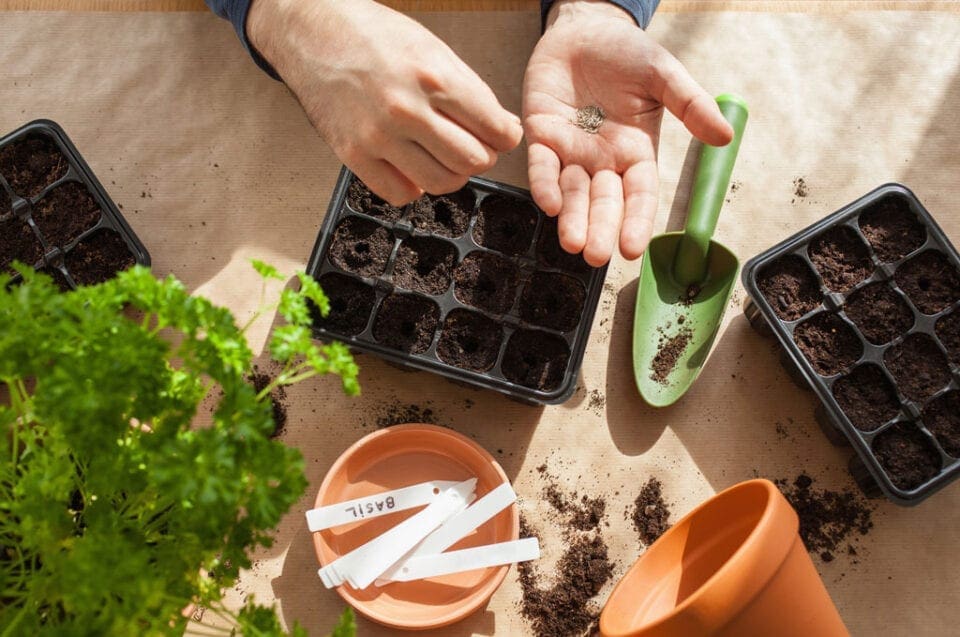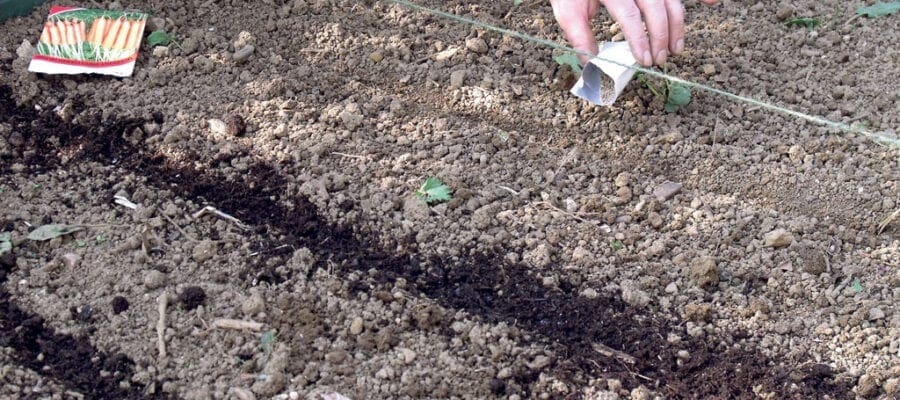
Some vegetables are sown direct and then thinned out as they grow and are harvested where they were originally sown. However there is another technique; this uses a nursery bed to sow seeds in to and these are moved to their final positions when they are small plants.
Traditionally crops such as brassicas (cabbages, kale, cauliflowers, Brussels sprouts etc.) and also leeks and seed raised onions are sown in nursery rows outside for transplanting once they are well established – in the case of brassicas once they are 10-15cm (4-6in) tall and with leeks when pencil thick. Generally however, all seeds should be sown as thinly as possible to give each plant room to grow.
Sowing indoors If sowing seeds indoors you have the choice of using standard seed trays or cell trays (modules). The former save space and are the most practical if you are growing on a sunny windowsill indoors. However cell trays have lots of advantages over seed trays or sowing direct outdoors. They are:
- Less root disturbance than the traditional method.
- Time saved in pricking out seedlings and thinning.
- Protection from pests for your seedlings and young plants until established.
- More control over the growing conditions and protection from late frosts.
- No competition from weeds.
Generally speaking, the only crops which are not suitable for sowing in trays are root veg such as carrots and parsnips, which tend to fork if disturbed. Crops which have ahabit of running to seed prematurely can be sown in trays, but need care. These include beetroot, chard and fennel. They must be planted before they’ve had a chance to become root bound and the roots must not be disturbed.
How to sow

- First stretch a line or place a straight edge over the soil where you wish to sow your seeds.
- Choose a calm day –sowing tiny seeds on a windy day would be a challenge for any gardener.
- Make a drill (groove) in the soil to the recommended depth. For this use a dibber stick or the edge of a hoe or rake.
- Dribble water along the drill.
- To sow, tap the corner of the seed packet along the row or put some seed in one hand and then gently tap this hand as you move along the row. Use a rake or your hand to pull the soil over the seeds. Do not bury them too deeply. Label and water well.
Sowing in containers – preparing to sow
Some vegetables benefit from being grown in containers first such as beans, courgettes and brassicas. Plants with large seeds and subsequently large leafy seedlings do better if started off in small pots or large cell trays, sowing one seed per pot or cell.
Examples of crops sown this way include courgettes and squashes including pumpkins and butternut. Simply fill your pots or trays with fresh seed compost, picking out any hard lumps as you go.
A thin layer of sieved-out lumps and fibre can be placed in the bottom of seed trays or cells prior to filling. Never compress the compost as you will drive out the air and seeds need this to thrive. Instead, gently tap the tray on the bench or tamp very lightly with a wooden tamper to settle the compost and to level the surface before watering thoroughly.
If you are using a traditional seed tray, before settling the compost take a piece of timber long enough to overlap the sides of the tray and scrape it over the top of the tray to take off excess compost. Then, after tamping, the level of the compost will be 6mm (1⁄4in) or so below the edge of the tray, allowing room for more fresh compost or vermiculite.
Cell tray growing

These containers are ideal for starting off a lot of vegetable plants such as brassicas or lettuce. They come in a range of sizes and with just one plant in each, the roots do not become entangled. They can also be transplanted with less stress to the plant itself, allowing it to grow on quickly in its new environment without problems.
Sowing in cells If you are using acell tray, dib a hole to an appropriate depth for the seed (check the seed packet for advice) using a dibber.
Simply drop one seed into each hole before covering with more compost and water well. Cover the trays with a propagator lid until the seeds germinate.
Deep roots Sweetcorn and beans have large seeds and do well sown in deep containers. You can buy deep pots or make your own using rolled newspaper or toilet rolls.
Sowing in trays
If you are sowing into trays, simply scatter the seeds lightly over the surface as evenly as you can, tapping them from the palm of your hand or shaking from the packet. Mix very fine seeds with an equal quantity of dry silver sand and sprinkle evenly over the compost.
Cover your seeds to the required depth with sieved compost or fine vermiculite –the correct depth will be stated on the seed packet. Water well and allow the seeds to drain before covering with a propagator lid and placing in a warm spot on a sunny windowsill or similar.





